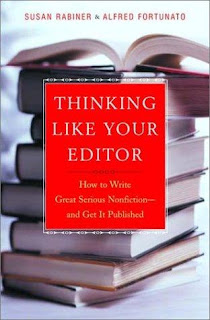I’m reading Thinking Like Your Editor: How to Write Great Serious Nonfiction–and Get it Published as I prepare my book proposal. The authors Susan Rabiner and Alfred Fortunato raise a couple of points that I find very difficult to balance. One is that a way to tell great non-fiction is by what is left on the cutting room floor. The second is that you can only argue from the facts on the page, not the ones in your head (or left on the floor).
I tend to over-write (my dissertation was 800+ pages long, which was due to over-writing and also a very large topic), giving all the interesting facts and stories I found in my research. When I then edit it down to a reasonable length, I seem to leave out necessary facts for my thesis. Maybe it is that readers always want more than you can give them, but I think it’s also because I bounce back and forth between extremes as I finally begin to settle into the middle path of good writing. Another problem is that I want my work to be primary-source driven instead of thesis-driven. I always want the people in my work to drive the article/book forward instead of my authorial voice. That last part is a combination of my personality (which relies heavily on synthesis) and being a white girl doing black history. But every standard of good writing wants the authorial voice to come forward.
One of my other problems I have is that I always have a reason for why I include a certain factoid or anecdote. I may not always tell you what it is (trying to cut down on length) and it may not drive forward the primary thesis, but I always have a reason. So just asking me to justify every quote does not necessarily help me cut down on the number of quotes I use. However, I think that Rabiner and Fortunato’s argument rules in Chapter 5 are going to help me as I continue to work on offering nuanced, critical writing that also does not lose the narrative drive. I also think I’m going to share that chapter with my students in my historical methods class as they learn how to write an argument. I usually have them diagram the argument of a historical essay, but I think the combination of Rabiner and Fortunato with diagraming an article will work better than the article alone.


One Thought on this Post
S-USIH Comment Policy
We ask that those who participate in the discussions generated in the Comments section do so with the same decorum as they would in any other academic setting or context. Since the USIH bloggers write under our real names, we would prefer that our commenters also identify themselves by their real name. As our primary goal is to stimulate and engage in fruitful and productive discussion, ad hominem attacks (personal or professional), unnecessary insults, and/or mean-spiritedness have no place in the USIH Blog’s Comments section. Therefore, we reserve the right to remove any comments that contain any of the above and/or are not intended to further the discussion of the topic of the post. We welcome suggestions for corrections to any of our posts. As the official blog of the Society of US Intellectual History, we hope to foster a diverse community of scholars and readers who engage with one another in discussions of US intellectual history, broadly understood.
And I thought my dissertation was long!